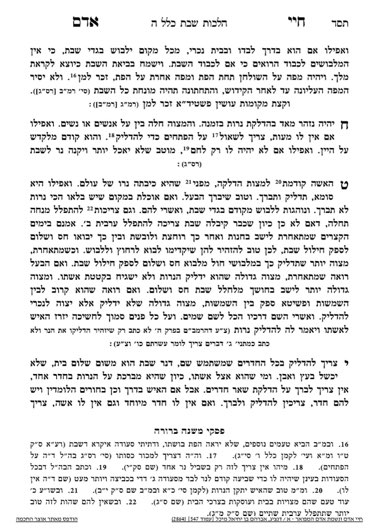We have finished siman 10, discussing different scenarios of where one lights. Today, we will discuss additional points related to the siman.
We learned that a person has a chiyuv hadlakah both in the makom achila (place they are eating) and the makom sheina (place they are sleeping). If one has the option of lighting either in their makom achila or makom sheina, it is preferable to light in the makom achila. However, if a person has a specific, unique makom sheina but does not have a specific, unique makom achila, it is preferable to light in their makom sheina, as the makom sheina is clearly a chiyuv, while the makom achila is not. For example, if a person is staying at a hotel for a simcha, theoretically it is preferable that one light in their hotel room, which is unique to them, as opposed to the makom achila, which many people will be lighting and it is not a certain makom chiyuv (S0131). Practically, the hotel will likely not allow for one to light in their room, and if so, one is not allowed to break their lessee agreement. If they do, it is a question of gezeilah.
Regarding making a bracha on the electric lights in one’s room, Rav Moshe held that one could make a bracha, but others disagree. One should ask their rav.
The minhag of many is to light and make a bracha on candles in the makom achila, even though it is not unique to them. Preferably, one should make sure there is some illumination in their room, and they should cover that electric illumination with the bracha they make in the makom achila. We have already learned (S0131) that one should ensure that when lighting in the makom achila, it is actually in the room in which they are eating, and not in some side room. If one is not able to light in their room, and is not able to light in the makom achila, they do not make a bracha.
Regarding bochurim in a yeshiva, they have a chiyuv to make sure there is sufficient illumination in the dormitory. They also have a chiyuv hadlaka in the makom achila. There is no need for them to be mishtateif b’perutah. Since they pay to eat together, they function as a family unit, so the bracha made by the person lighting covers the other bochurim.
If the dining room and dormitory are in the same building, the bracha made in the dining room will cover the dormitory, as it covers the entire building (S0134).
If they are separate buildings, if they are on the same campus, one may be able to rely on the Derech Hachaim (S0134) that the bracha can extend even outside of the house. If they are not on the same campus, even if they sleep in people’s homes, if they have their own rooms or their own section of the house, they would have a separate chiyuv to light over there. It is not clear to Rabbi Reingold why the minhag is not for them to light. It could be out of concern for the fire hazard of lighting candles in those places, and therefore they fulfill their chiyuv with electric lights and without making a bracha. However, there is arguably a chiyuv in those places.
If a person is going to their in-laws for a seudah, and sleeping at home, they light and make a bracha at home.
Summary
- It is preferable to light in the makom achila over the makom sheina.
- If one will not be allowed to light in the makom achila, they can light in the makom sheina.
- If one does not have a specific, unique makom achila, but they do have a specific, unique makom sheina, it is preferable to light in the makom sheina
- If one lights in another room, or far away from the actual seudah, or in a way that the neiros do not enhance the seuda, they should not make a bracha.
- Bochurim in yeshiva have a chiyuv hadlakah both in their makom achila and makom sheina. They do not have to be mishtateif b’perutah. If their makom achila and makom sheina are in the same building, the bracha in the makom achila covers the makom sheina, but if not, they arguably have a chiyuv to light in the makom sheina as well.



